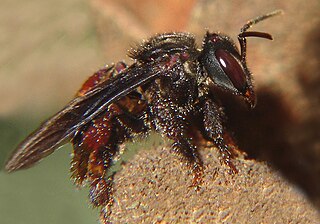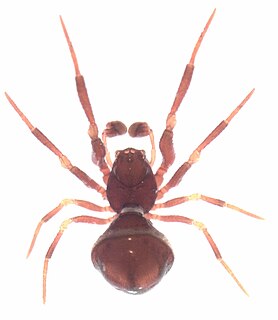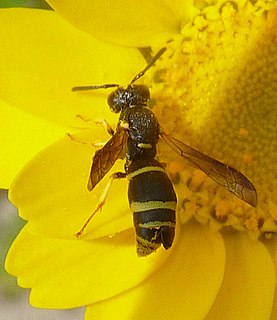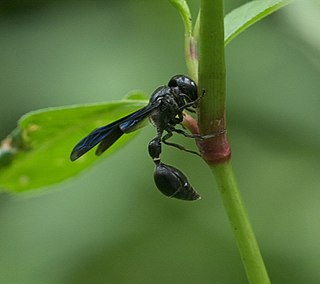
Eucinetidae is a family of beetles, notable for their large coxal plates that cover much of the first ventrite of the abdomen, sometimes called plate-thigh beetles. The family is small for beetles, with about 50 species in 11 genera, but are found worldwide.

Trigona is the largest genus of stingless bees, comprising over 80 species exclusively occurring in the New World, and formerly including many more subgenera than the present assemblage; many of these former subgenera have been elevated to generic status.
Troglohyphantes spinipes, one of several species sometimes referred to as the Kočevje subterranean spider, is a species of spider in the family Linyphiidae. It is endemic to Slovenia.

Trigona spinipes is a species of stingless bee. It occurs in Brazil, where it is called arapuá, aripuá, irapuá, japurá or abelha-cachorro ("dog-bee"). The species name means "spiny feet" in Latin. Trigona spinipes builds its nest on trees, out of mud, resin, wax, and assorted debris, including dung. Therefore, its honey is not fit for consumption, even though it is reputed to be of good quality by itself, and is used in folk medicine. Colonies may have from 5,000 to over 100,000 workers.

Zabrus (Pelor) spinipes is a species of ground beetle belonging to the family Carabidae, genus Zabrus, subgenus Pelor.

Novanapis is a genus of South Pacific araneomorph spiders in the family Anapidae, containing the single species, Novanapis spinipes. It was first described by Norman I. Platnick & Raymond Robert Forster in 1989, and has only been found in New Zealand.
Trujillina is a genus of Caribbean wandering spiders first described by E. B. Bryant in 1948. As of April 2019 it contains only three species on Hispaniola and in Puerto Rico: T. hursti, T. isolata, and T. spinipes.

Odynerus spinipes, the spiny mason wasp, is a species of potter wasp from western Europe. It is the type species of the genus Odynerus, being first described by Carl Linnaeus in his landmark 1758 10th edition of Systema Naturae.

Zethus spinipes is a species of stinging wasp in the family Vespidae.
Dilophus spinipes is a species of March fly in the family Bibionidae.
Eustictus is a genus of plant bugs in the family Miridae. There are more than 30 described species in Eustictus.
Eustictus spinipes is a species of plant bug in the family Miridae. It is found in North America.
Caccoplectus spinipes, the spine-legged pselaphid, is a species of ant-loving beetle in the family Staphylinidae. It is found in Central America and North America.
Caccoplectus is a genus of ant-loving beetles in the family Staphylinidae. There are about nine described species in Caccoplectus.
Metepeira spinipes is a species of orb weaver in the spider family Araneidae. It is found in the United States and Mexico.
Euscaphurus saltator is a species of plate-thigh beetle in the family Eucinetidae. It is found in North America.
Euscaphurus is a genus of plate-thigh beetles in the family Eucinetidae. There are at least three described species in Euscaphurus.
Sternechus is a genus of true weevils in the beetle family Curculionidae. There are more than 50 described species in Sternechus.

Xyleborinus is a genus of typical bark beetles in the family Curculionidae. There are more than 80 described species in Xyleborinus.
Huleechius is a genus of riffle beetles in the family Elmidae. There are at least two described species in Huleechius.






